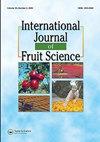基于多路微卫星指纹图谱的覆盆子品种真伪鉴定
IF 2.4
3区 农林科学
Q2 HORTICULTURE
引用次数: 0
摘要
树莓(Rubus idaeus L.)是重要的无性繁殖果树。它们被用作食品,药用植物,以及制药和化妆品工业。为了保护知识产权,建立快速、准确的品种鉴定方法是十分重要的。树莓品种的分化可通过两种途径进行:表型水平上的形态描述符和分子水平上的分子标记。其中常用的是SSRs,它信息量大,易于评分,并且具有良好的基因组覆盖率。考虑到19个先前发表的SSR分子标记,我们为每个选定的基因型选择了最特异性的位点,并为研究中包括的每个基因型建立了特异性指纹图谱:4个红覆膜莓品种(Polka, Glen Ample, Meeker, Rose de Côte d ' or)和2个基因型(Sicoly和Dieffenbach)。我们研究的目的是通过特定的扩增片段模式来证明所研究的覆盆子基因型之间的差异,每个基因型都是独特的,并且基于简单序列重复序列(SSRs)。此外,所建立的指纹图谱可成功地在随机选择的未知基因型上进行检测。本文章由计算机程序翻译,如有差异,请以英文原文为准。
Determination of Raspberry Cultivar Authenticity Based on Multiplexed Microsatellite Fingerprinting
ABSTRACT Raspberries (Rubus idaeus L.) are important vegetatively propagated fruit plants. They are used as food, as medicinal plants, and in pharmaceutical and cosmetic industry. For the protection of intellectual property rights, it is very important to have efficient methods that enable fast and accurate identification of cultivars. Raspberry cultivars can be differentiated in two ways: on the phenotypic level with morphological descriptors and on the molecular level with molecular markers. Among the frequently used are SSRs, which are highly informative, easy to score and have a good genome coverage. Considering 19 previously published SSR molecular markers, we selected the most specific loci for each selected genotype and developed specific fingerprint for each of the genotypes included in the study: four red raspberry cultivars (‘Polka,’ ‘Glen Ample,’ ‘Meeker,’ ‘Rose de Côte d’Or’) and two genotypes named Sicoly and Dieffenbach. The aim of our investigation was to demonstrate the differentiation between studied raspberry genotypes by specific amplified fragment patterns, which were unique for each genotype and were based on simple sequence repeats (SSRs). Furthermore, the developed fingerprints were successfully tested on randomly chosen, unknown genotypes.
求助全文
通过发布文献求助,成功后即可免费获取论文全文。
去求助
来源期刊

International Journal of Fruit Science
Agricultural and Biological Sciences-Agronomy and Crop Science
CiteScore
6.40
自引率
0.00%
发文量
64
审稿时长
10 weeks
期刊介绍:
The International Journal of Fruit Science disseminates results of current research that are immediately applicable to the grower, extension agent, and educator in a useful, legitimate, and scientific format. The focus of the journal is on new technologies and innovative approaches to the management and marketing of all types of fruits. It provides practical and fundamental information necessary for the superior growth and quality of fruit crops.
This journal examines fruit growing from a wide range of aspects, including:
-genetics and breeding
-pruning and training
-entomology, plant pathology, and weed science
-physiology and cultural practices
-marketing and economics
-fruit production, harvesting, and postharvest
 求助内容:
求助内容: 应助结果提醒方式:
应助结果提醒方式:


